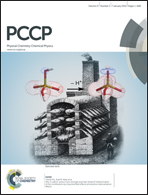A backside fluorine-functionalized graphene layer for ammonia detection†
Abstract
Graphene is a remarkable material with the best surface to volume ratio as a result of its 2D nature, which implies that every atom can be considered as a surface one. These features make graphene attractive for use as a sensing material; however, the limiting factor is the chemical inertness of pristine graphene. Here we propose a method to create reactive centers by removal of fluorine atoms from the outer surface of fluorinated graphene while preserving the backside fluorination. Such partially recovered graphene layers were produced by the action of hydrazine-hydrate vapor on initially non-conducting fluorinated graphite. The reduction degree of the material and its electrical response revealed upon ammonia exposure were controlled by measuring the surface conductivity. We showed experimentally that the sensing properties depend on the reduction degree and found the correlation of the adsorption energy of ammonia with the number of residual fluorine atoms by the use of quantum-chemical calculations.


 Please wait while we load your content...
Please wait while we load your content...